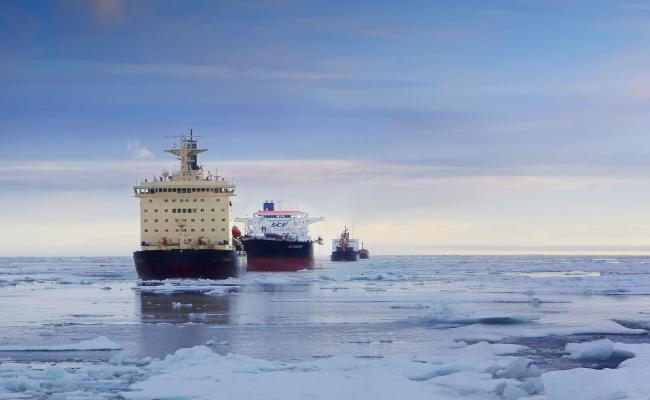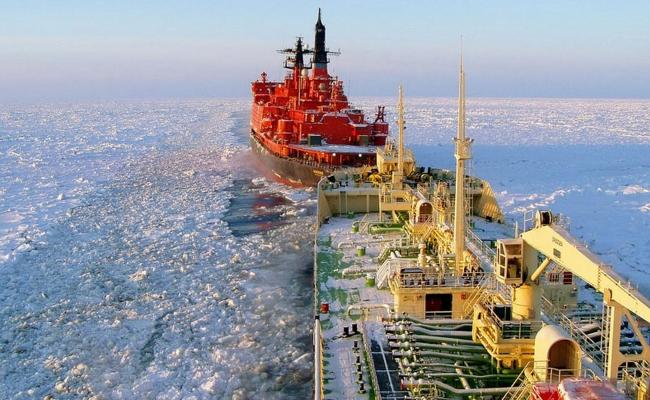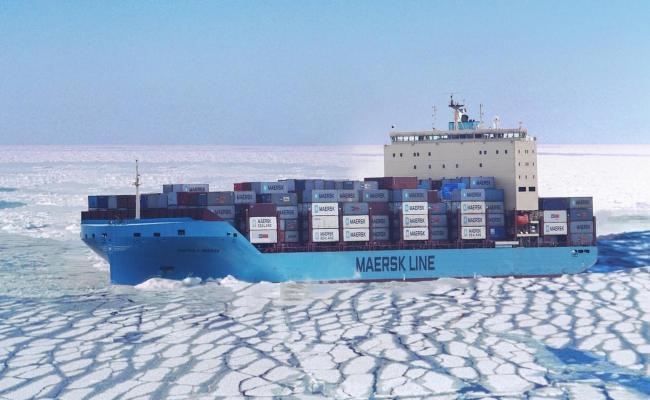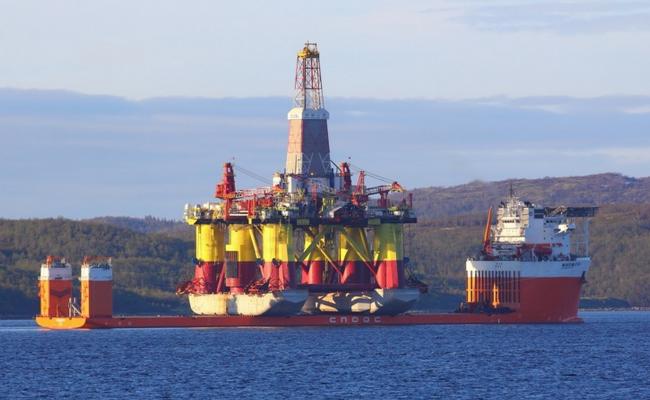Chinese Shipping Company COSCO To Send Record Number of Ships Through Arctic
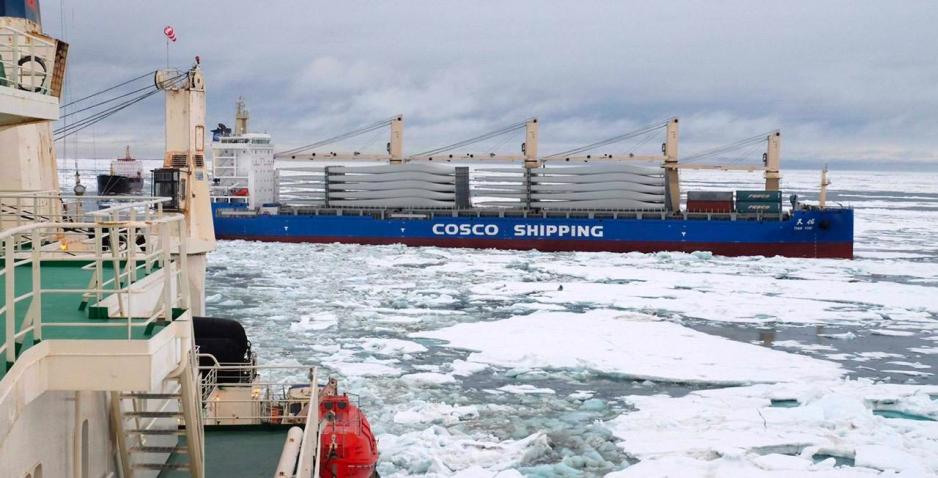
The Tian You transporting windmill blades and other parts along the NSR in 2018. (Source: Courtesy of Rosatomflot)
COSCO continues to step up its operations in the Arctic. The company plans to conduct 14 transit voyages along Russia’s Northern Sea Route between July and October – nearly twice the number of 2018.
COSCO Specialized Carriers Company, a subsidiary of COSCO Shipping Group, the world’s third largest shipping company, began sending ships along Russia’s Northern Sea Route in 2013.
The Yong Sheng became the first Chinese vessel to transit along the route. In the following years the company increased its activity, conducting two transits in 2015, six in 2016, five in 2017, and eight in 2018.
This year it aims to conduct at least 14 transits – full voyages from Asia to Europe or vice versa – along the burgeoning route. At least ten different vessels are scheduled to travel through the Arctic, with one vessel, Tian Hui, expected to make three full transits. This number of transits in a single year would be a first for a non-icebreaking vessel.
COSCO plans to send its first vessel, the Tian Hui from Finland to China in the middle of July, depending on ice conditions. Last year, the early summer navigation season was hampered by lingering ice and Rosatomflot’s icebreakers had to extend their icebreaking services by two weeks.
Over the following 14 weeks the company aims to dispatch six voyages in a westward direction from Asia to Europe and eight trips in the opposite direction. While some of the planned voyages have already received the required permits from Russia’s Northern Sea Route Administration, others have not.
In addition, the Tian Jian has already received a permit for an as-of-yet unknown trip, which may further increase the total number of COSCO trips for 2019.
While experts generally remain skeptical about the economic viability of large-scale cargo traffic along the route, COSCO has increased its level of engagement every single year.
As Michael Byers, Canada Research Chair in Global Politics and International Law at the University of British Columbia previously remarked, “the COSCO voyages indicate a serious intent on the part of the Chinese government, via a state-owned company, to take advantage of increasing Arctic shipping routes.”
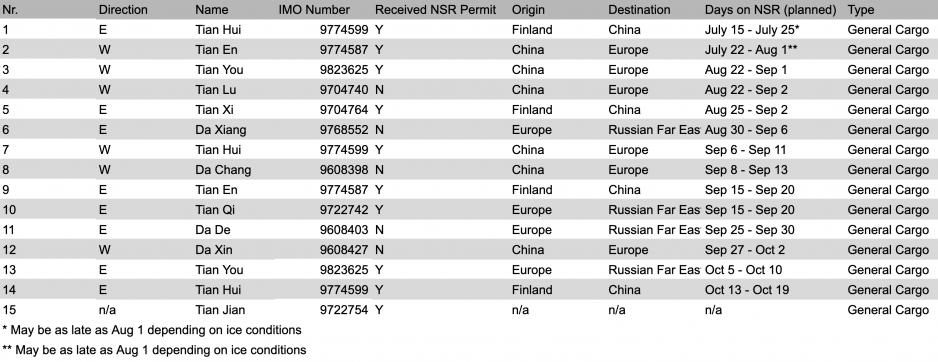
List of planned COSCO voyages between July - October 2019. (Source: Author’s own work based on information from COSCO, NSR Administration and Mika Mered)
Reducing CO2 emissions
COSCO Specialized Carriers Company operates a large fleet of 130 specialized vessels, including heavy lift, semi submersibles and car carriers. More than twenty of its vessels have now ventured through the Arctic since 2013.
In a recent company presentation COSCO highlighted that its voyages across the Arctic Ocean have reduced sailing time by 280 days resulting in a reduction of roughly 27,500 tons of CO2 – equivalent to the annual per capita CO2 emissions of 3,300 Norwegians.
The company did not discuss any plans for phasing out heavy fuel oil in the region. A ban for this particularly dirty type of fuel remains under discussion at the International Maritime Organization and a decision was recently postponed until at least 2020.
The company also highlighted that despite the shorter sailing distance and time as well as a reduction in emissions and pollutants, the route is limited to just four months out of the year, remains challenging as it often requires assistance from icebreakers, and has limited communications and navigational aid available due to the high latitude.
Broad Chinese interests along NSR
Chinese companies also recently stepped up their engagement in Arctic natural gas endeavors. Last week the China National Petroleum Corporation (CNPC) and the China National Offshore Oil Corporation (CNOOC) each purchased a 10 percent stake in Novatek’s Arctic LNG 2 project, at an estimated cost of $5.6bn.
This follows previous investments in the Yamal LNG project of around $9bn.
Maersk does not see the Northern Sea Route as a viable commercial alternative.
In addition to COSCO’s voyages, Chinese companies are part-owners and operate nine out of 15 Arc7 LNG carriers. This makes China by far the largest foreign operator of vessels along Russia’s NSR. COSCO also aims to become a major partner in the transport of LNG on the route.
Last week it signed an agreement with Novatek for the formation of the Maritime Arctic Transport LLC, which aims to establish a long-term partnership for the shipping of hydrocarbons on the route and the organizing of transit cargo.
China Oilfield Services Limited’s (COSL) Nan Hai Ba Hao platform has also been active in the Arctic Ocean working for Gazprom during the past two summers and will return again this year. It total it has discovered more than a trillion cubic meters of natural gas with 500 billion cubic meters alone coming from discoveries during 2018.
During the summers of 2016 and 2017 COSCO vessels were instrumental in delivering prefabricated modules for the construction of the Yamal LNG plant to the port of Sabetta. The company has not yet confirmed if similar shipments will be conducted for the construction of the Arctic LNG 2 facility for which foundation work began earlier this year.
If COSCO vessels, especially semisubmersibles, are used to deliver construction material, the number of Chinese vessels on the route this summer could exceed two dozen.
COSCO remains the only major international operator on the route. Denmark’s Maersk conducted a highly publicized transit of the first container ship - the Venta Maerk - on the route, but has denied any interest in repeating such a voyage.
“We do not have any plans and currently, Maersk does not see the Northern Sea Route as a viable commercial alternative to existing east-west routes,” confirmed Maersk Press Officer Janina von Spalding to HNN.


